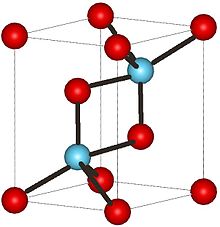
Uranium nitride

Uranium nitride refers to a family of several ceramic materials: uranium mononitride (UN), uranium sesquinitride (U2N3) and uranium dinitride (UN2). The word nitride refers to the −3 oxidation state of the nitrogen bound to the uranium.Simple cubic (P)Body-centered cubic (I)Face-centered cubic (F) Uranium nitride refers to a family of several ceramic materials: uranium mononitride (UN), uranium sesquinitride (U2N3) and uranium dinitride (UN2). The word nitride refers to the −3 oxidation state of the nitrogen bound to the uranium. Uranium nitride has been considered as a potential fuel for nuclear reactors. It is said to be safer, stronger, denser, more thermally conductive and having a higher temperature tolerance. Challenges to implementation of the fuel include a complex conversion route from enriched UF6, the need to prevent oxidation during manufacturing and the need to define and license a final disposal route. The common techniques for generating UN is carbothermic reduction of uranium oxide (UO2) in a 2 step method illustrated below. Sol-gel methods and arc melting of pure uranium under nitrogen atmosphere can also be used. Another common technique for generating UN2 is the ammonolysis of uranium tetrafluoride. Uranium tetrafluoride is exposed to ammonia gas under high pressure and temperature, which replaces the fluorine with nitrogen and generates hydrogen fluoride. Hydrogen fluoride is a colourless gas at this temperature and mixes with the ammonia gas. An additional method of UN synthesis employs fabrication directly from metallic uranium. By exposing metallic uranium to hydrogen gas at temperatures in excess of 280 °C, UH3 can be formed. Furthermore, since UH3 has a higher specific volume than the metallic phase, hydridation can be used to physically decompose otherwise solid uranium. Following hydridation, UH3 can be exposed to a nitrogen atmosphere at temperatures around 500 °C, thereby forming U2N3. By additional heating to temperatures above 1150 °C, the sesquinitride can then be decomposed to UN. Use of the isotope 15N (which constitutes around 0.37% of natural nitrogen) is preferable because the predominant isotope, 14N, has a not insignificant neutron absorption cross section which affects neutron economy and, in particular, it undergoes an (n,p) reaction which produces significant amounts of radioactive 14C which would need to be carefully contained and sequestered during reprocessing or permanent storage. Each uranium dinitride complex is considered to have three distinct compounds present simultaneously because of decomposing of uranium dinitride (UN2) into uranium sesquinitride (U2N3), and the uranium mononitride (UN). Uranium dinitrides decompose to uranium mononitride by the following sequence of reactions: Decomposition of UN2 is the most common method for isolating uranium sesquinitride (U2N3).
